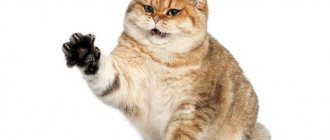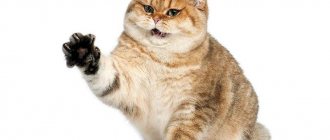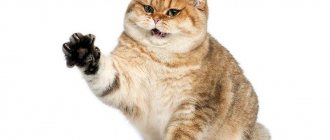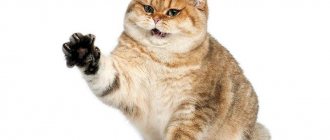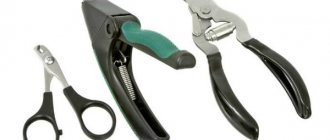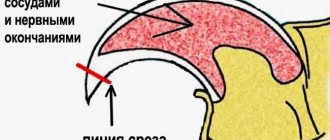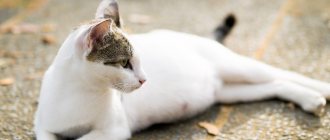For many domestic cats, nail trimming is a must. Growing nails cause discomfort to animals, and if they are not shortened in time, inflammation may begin. However, you need to properly prepare for a cat “manicure” and learn the technique of performing it. Then the procedure will take place with minimal stress and will not cause pain to the cat.
Which animals are not recommended for the procedure?
There is no need to trim the claws of a cat that roams freely outside. She needs her nails to climb trees, hunt and defend herself from other four-legged animals.
Also, the procedure is not performed on kittens under 1 month of age. Their claws are not yet formed. Early cutting negatively affects the structure of the nail plate and leads to delamination.
But already at 2 months the claws are strongly extended, and the kitten begins to scratch. At this time they can already be cut.
What tools can you use?
There are special nail clippers for trimming cat claws. It is not recommended to use nail scissors. They are designed for thin and flat nail plates of people. Such cutting tools lead to delamination.
There are several types of nail clippers:
- Blisters - resemble nail scissors, but have blades curved at the ends, designed for cat claws.
- Secateurs are equipped with a spring, which is located between the handles. As a rule, such models have a limiter. It allows you to cut only the desired length.
- Guillotines are similar to cigar scissors. The nail is placed in the hole at the end. When the handles are closed, the blade lowers and cuts the claw. The tool is suitable for cats with thick nail plates.
Each owner chooses the model that is convenient for him to use. The main thing is that it is made of high-quality materials and sharpened.
Additionally, you can buy an electric trimmer that allows you to quickly trim your nails. However, not all cats react calmly to it - the buzzing device scares the animals.
Important. When cutting, the blade of the guillotine nail clipper must move from bottom to top, otherwise the risk of crushing the nail increases. This is especially dangerous for kittens whose claw plates are not yet strong enough.
The best nail clippers for cats
To ensure that the purchased nail clipper model does not disappoint, choose the tool responsibly. The guillotine is often chosen by experienced breeders.
Beginner “users” prefer pruning shears. Their mechanism of action allows you to avoid injuries resulting from negligence.
Nail clippers-scissors are bought by those who are more accustomed to using accessories that look like manicure devices for people.
When choosing, you need to pay attention to the following criteria:
- Convenience – the handles of the nail clipper should match the size. The rubberized surface will provide a good grip on the tool.
- Blade - a high-quality nail clipper should be made of stainless steel. The edges of the blade should not have jagged or rough edges.
It’s good if the design of the manicure tool includes a limiter that minimizes the risk of injury.
How often is nail trimming done?
The frequency of haircuts depends on the individual characteristics of the cat. For some, it is enough to carry out the procedure once a month, for others – every 2-3 weeks.
As a rule, light-colored nails grow faster. And in cats that prefer active games, partial wear occurs naturally. To determine the exact timing, you just need to carefully observe your pet.
For your information. A cat needs to have its claws trimmed before an exhibition, competition or other important event.
Preparing for the first procedure
To trim a cat's claws with minimal stress, the animal is first accustomed to this procedure. It is better to start doing this in childhood. Kittens adapt to any changes more easily than adults.
For your information. There are cases where adult cats, accustomed to clinging with their claws while jumping, have fallen and been injured due to the fact that their nails were suddenly cut.
Preparations for grooming begin at a time when the cat is not doing anything (not playing, licking itself, eating or sleeping). They take her in their arms and stroke her affectionately.
Then they carefully move to the paws - they try to touch, lightly massage, imitate a haircut. At the same time, they talk to the pet and try to switch its attention to something interesting so that it does not break out.
As a rule, kittens do not like to have their paws touched, so the first 2-3 times they will get irritated and run away. But if you regularly repeat this exercise, the baby will get used to the manipulations. To reinforce the positive associations, he is given a treat at the end.
When the kitten begins to be calm about being touched, they begin to “rehearse” the haircut itself:
- put the pet in the desired position;
- take each paw in turn;
- examine the nails, press on the pads.
If the kitten tolerates all the actions, he is sincerely praised.
Then the pet is introduced to the nail clipper. It is important to show that the tool does not pose any danger. After the animal begins to treat him calmly, you can cut the kitten’s claws for real.
What can't you do?
Cats, like all people, are sensitive to their environment. They also read the emotions and mood of their owners.
What not to do during a haircut:
- scream and get irritated - the pet will experience even greater fear, and in the future it will be very difficult to get him to agree to the procedure;
- force by force - there is no need to force the animal to submit by violent means;
- catching a kitten during games - he will not say “thank you” for this, but indignation and aggression on the part of the pet are guaranteed.
Step-by-step instruction
A cat's claws consist of a keratinized layer, inside of which there is a pulp - a collection of nerve endings and blood vessels. When trimming, it is important not to touch a sensitive area, otherwise it will be very painful for your pet and blood will come from the wound.
In cats with light-colored claws, the pulp is clearly visible - it looks like a pink, crescent-shaped area. You can point your paw at a bright light or use a flashlight - the picture will be clearer.
It is more difficult to trim the claws of cats with dark pigmentation - you will have to act blindly. In this case, carefully cut off 1-2 mm at a time until the color inside becomes a little lighter - this is the beginning of the pulp.
For your information. Before cutting, remove the hair between the pads so that it does not interfere.
Nail trimming begins when the cat is calm, relaxed and ready to communicate. At this point, the owner should disinfect his hands and nail clippers, prepare cotton pads and antiseptic in case of injury.
Step-by-step instructions for trimming nails at home:
- The owner takes a comfortable position, puts the cat on his lap with his back to himself or lays him on his back. Particularly mobile pets can be wrapped in a terry towel.
- He takes the paw in his hand and presses on the pad to expose the claw.
- He brings the nail clipper to his paw. If the cat does not show concern, clicks it. In case of anxiety, he strokes and calms the pet, after which he repeats the manipulation.
- Now quickly and confidently sets the nail cutter 1-2 mm to the pulp and trims the claw so that the edge remains sharp. If you cut the platinum at the wrong angle, you will be more likely to hit the pulp.
- At the end, the cuts are rounded off with a nail file, giving a natural shape. In the future, you will be able to trim your claws less frequently if you regularly trim the overgrown areas.
If you trim your cat's nails correctly, your cat will not experience any discomfort. In fact, many animals struggle and hiss not because of pain, but because they are scared.
In order not to overwork the cat, the haircut is carried out in several passes. For example, one paw is treated daily.
Popular cat haircuts
There are exhibition and home haircuts.
The following hairstyles are ideal for home use:
- lion - all hair is cut off except the head, the tip of the tail and the paws below the “knees” and “elbow”;
- puss in boots - in this case, hair is left on the head, tail and the entire surface of the limbs;
- summer
Exhibition or model hairstyles are created by experienced groomers.
There are many options for “laying”:
- continental,
- puma,
- harlequin,
- modern,
- the Dragon.
If your plans do not include a cat grooming or the animal stubbornly does not give in to the hairdresser’s onslaught, then you will have to monitor and care for the fur as usual:
- periodic combing;
- timely removal of matted hairs;
- the use of shampoos and conditioners that help soften and straighten the hairs.
Long-haired breeds must be given special products that dissolve mats in the stomach, or use ready-made food that already contains the necessary absorbable ingredients. And to prevent heat stroke, you will have to get an air conditioner.
Well, a video on the topic of how cats are cut in salons:
What to do if the animal is not given
To trim the claws of cats that categorically refuse this procedure, they use fixing overalls. They provide access to all limbs, but do not allow the pet to move freely.
At first, it is advisable to carry out the haircut with an assistant who will hold the animal. If the cat meows loudly and struggles, take a break. Let her rest and calm down for a while, then you can try again.
Important. You should not swear or shout at a cat if it resists while trimming its claws. Aggression from the owner will only frighten her. In the future, the pet will try by all means to avoid the unpleasant procedure.
What to cut your hair with
Most often, cat owners use two devices when trimming their claws:
- Trimmer.
If this is your first time encountering a similar procedure and you don’t know how to trim a cat’s claws correctly, it is better to choose a special tool for this purpose—a guillotine-type trimmer. It is a device with a cutting blade that extends when you press the handle.
- Claw clipper.
A nail clipper remains a popular tool for trimming cat claws. It’s not difficult to trim a cat’s claws with it, the main thing is not to cut too long, so as not to touch the blood vessels. In general, nail trimming tools are:
- nail clipper;
- disinfectant;
- cotton wool or sponge;
- nail file.
There is no consensus on how to properly trim a cat's claws and what tools to use; you will have to try all the methods and choose the one that suits you and your pet.
Before trimming claws, you need to prepare all the necessary components in advance:
- the instrument itself;
- a hard nail file, or better yet, sandpaper or a block to correct the tips of the cut claws.
cotton wool and a hemostatic solution in case of accidental cuts to the pet;
Place the cat in your arms, with its back facing you. Then, take the foot and press lightly. Treat the claws with a disinfectant and carefully trim them with a nail clipper, smoothing the surface of the claw with a nail file if necessary.

